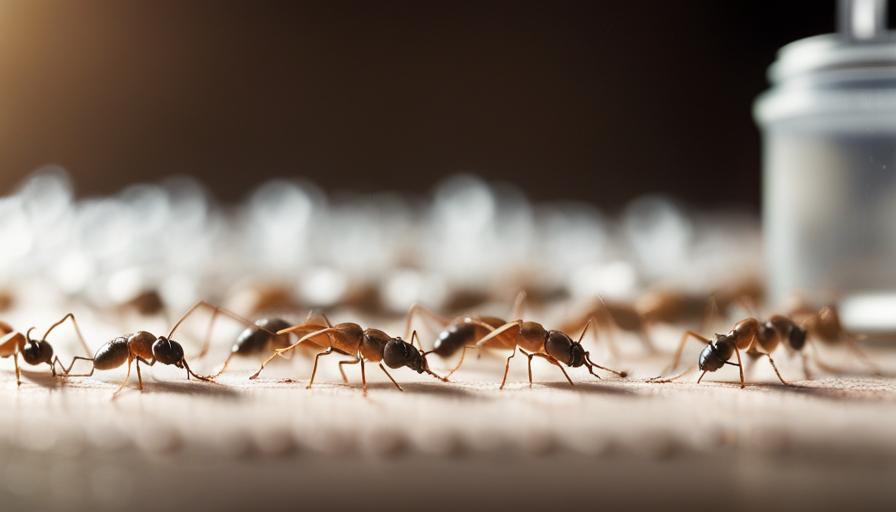Are you dealing with an infestation of tiny black ants in your home, leaving frustrating trails everywhere? Fear not, as I have just the solution for you. In this article, I will provide a step-by-step guide to eliminate these pesky pests from your home.
Picture this: an immaculate, ant-free home where you can finally relax without the constant annoyance of tiny black ants scurrying across your countertops. It’s time to take charge and reclaim your space!
First, we need to identify the ant species and locate their entry points. Armed with this knowledge, we can then implement a thorough cleaning routine and seal any cracks or openings that serve as their gateways.
But wait, there’s more! I’ll also reveal some natural ant repellents, DIY ant traps, and tips on removing food and water sources that attract these unwanted guests. And if all else fails, don’t hesitate to consult a professional pest control service.
So, let’s roll up our sleeves and bid farewell to those tiny black ants once and for all. It’s time to regain control of your home and enjoy a peaceful, ant-free environment. Let’s get started!
Key Takeaways
- Identifying the ant species and locating their entry points is important.
- Cleaning and sealing cracks and openings can help prevent ant invasions.
- Natural ant repellents (vinegar, peppermint oil, cinnamon, citrus peels) can be effective.
- Setting up ant bait stations can help eliminate ant colonies.
Identify the Ant Species
To properly address the issue of tiny black ants in your house, you need to identify the ant species. Understanding the behavior and habits of different ant species is crucial in developing an effective plan to get rid of them.
There are several ways to differentiate between different ant species. Firstly, examine the ants closely to determine their size, color, and physical characteristics. This can help narrow down the possibilities and provide insights into their nesting habits.
Secondly, observe their behavior. Some species, like the odorous house ants, leave a distinctive smell when crushed, while others, like carpenter ants, create sawdust-like debris near their nests.
Additionally, knowing the preferred food sources of different ant species can aid in identification.
Once you have identified the ant species, you can move on to locating their entry points. By understanding their habits and behaviors, you will be better equipped to track down where they are entering your home and take appropriate measures to prevent their entry.
Locate their Entry Points
Identify where these persistent little invaders are sneaking into your home and seal off their secret entrances. To effectively block ant entry points, you need to locate them first.
Ants are tiny creatures that can enter through even the tiniest cracks and crevices, so a thorough inspection is necessary. Start by examining the exterior of your house, paying close attention to areas where utility lines enter, gaps around windows and doors, and any cracks in the foundation. These are common entry points for ants.
Inside, check along baseboards, around plumbing fixtures, and near electrical outlets. Look for tiny trails of ants, as they often follow the same path when foraging for food.
To locate ant trails, keep a close eye on their movements. Follow any visible ants and observe where they are coming from and where they are going. Ants leave behind a pheromone trail, which attracts other ants to the same food source. By tracking their trails, you can determine the most active areas and focus your efforts on sealing those entry points.
Identifying and blocking ant entry points is crucial in keeping these pesky insects out of your home. Once you have sealed off their secret entrances, the next step is to keep your house clean and tidy.
Keep Your House Clean and Tidy
Maintaining a clean and organized home creates an environment that is less appealing to pesky ant invaders. Regular cleaning is of utmost importance when it comes to keeping these tiny black ants at bay. By eliminating their food sources and making sure everything is properly stored, you can significantly reduce the chances of an ant infestation.
To help you stay on top of your cleaning and organizing tasks, here are some tips:
| Organizing Tips |
|---|
| Declutter regularly |
| Store food properly |
| Seal garbage tightly |
| Clean up spills immediately |
| Vacuum regularly |
Decluttering regularly not only makes your home look neater but also eliminates potential hiding spots for ants. Storing food properly in airtight containers prevents ants from getting to it. Make sure to seal garbage tightly and take it out regularly to avoid attracting ants. Cleaning up spills immediately removes any potential food sources, making your home less appealing to ants. Lastly, vacuuming regularly helps remove food particles that may have fallen on the floor.
By following these organizing tips and maintaining a clean home, you can greatly decrease the likelihood of ant infestations. Now, let’s move on to the next step: sealing cracks and openings to further prevent ant invasions.
Seal Cracks and Openings
Sealing cracks and openings is like locking the door to your home, keeping unwanted ant invaders out. To effectively prevent tiny black ants from entering your house, it’s crucial to inspect and repair any cracks or openings in the foundation and walls.
Here are two important steps to help you get started:
-
Inspect and repair foundation:
- Carefully examine the foundation of your house for any visible cracks or holes.
- Use a sealant or caulk specifically designed for foundation repair to fill in any gaps.
- Pay close attention to areas where pipes, cables, or wires enter your home, as ants can use these entry points.
-
Hire an exterminator:
- If you’re unsure about your ability to properly seal the cracks, consider hiring a professional exterminator.
- An experienced exterminator can identify potential entry points and seal them effectively.
- They may also provide additional advice on preventing ant infestations and offer ongoing pest control services.
By taking these steps to seal cracks and openings, you can significantly reduce the chances of tiny black ants invading your home. In the next section, we’ll explore the use of natural ant repellents to further enhance your ant control efforts.
Use Natural Ant Repellents
Enhance your ant control efforts by incorporating natural ant repellents that will keep those pesky invaders at bay. Instead of relying solely on chemical pesticides, consider using natural ant repellent alternatives to create a safer and more environmentally-friendly solution.
Homemade ant deterrents can be effective in deterring ants from entering your home. One option is to use a mixture of vinegar and water. Ants dislike the strong scent of vinegar, so spraying a solution of equal parts vinegar and water along their entry points can discourage them from coming inside.
Another natural ant repellent is peppermint oil. Ants are repelled by the strong smell of peppermint, so placing a few drops of peppermint oil on cotton balls and placing them near ant trails can help deter them.
Additionally, cinnamon can act as a natural ant deterrent. Sprinkle cinnamon powder along windowsills, doorways, and other ant entry points to create a barrier that ants will avoid.
Another option is to use citrus peels, as ants dislike the smell of citrus. Place orange or lemon peels near ant trails or entry points to repel them.
By incorporating these natural ant repellents into your ant control strategy, you can effectively keep ants out of your home without relying on harmful chemicals. This will create a safer environment for you and your family.
Now, let’s move on to the next section about setting up ant bait stations.
Set Up Ant Bait Stations
To effectively control ants, it’s important to set up ant bait stations. These stations are an effective way to eliminate ant colonies in your home. Ant bait works by attracting ants to the bait, which they then carry back to their colony, ultimately leading to the elimination of the entire colony.
When it comes to the effectiveness of ant bait, it’s crucial to choose the right type. Look for ant baits that contain slow-acting insecticides, as these allow the ants enough time to transport the bait back to their nests. This ensures that the entire colony is affected.
Placement of ant bait stations is key to their success. It’s crucial to place the stations near ant trails and entry points, as this will ensure that the ants find the bait easily. Additionally, avoid placing the bait stations on top of or directly next to any ant trails, as this may deter the ants from accessing the bait.
By setting up ant bait stations and ensuring their proper placement, you can effectively control ant colonies in your home. However, it’s also important to remove food and water sources, as these attract ants. Transitioning to the next section, removing these sources will further discourage ants from invading your home.
Remove Food and Water Sources
By eliminating accessible food and water, you can create an inhospitable environment that will make ants think twice before invading your home. To prevent ant infestations and safely remove ants, it’s crucial to remove all sources of food and water that may attract these tiny black ants.
Start by cleaning up any spills or crumbs immediately and storing food in airtight containers. Make sure to seal all leaky pipes and fix any plumbing issues to eliminate water sources. Additionally, regularly empty and clean pet bowls, as even a small amount of leftover food can attract ants.
It’s also important to keep your kitchen and other areas of the house clean, wiping down countertops and sweeping floors regularly to remove any food particles. By taking these measures, you can greatly reduce the likelihood of ant infestations in your home.
Now, let’s move on to the next section and explore DIY ant traps as another effective method to get rid of these pesky ants.
Try DIY Ant Traps
Create homemade ant traps using common household items to lure and capture those pesky invaders. One effective method is to make a homemade ant spray by mixing equal parts of vinegar and water. Spray this solution directly onto ant trails or areas where they frequently appear. The strong smell of vinegar acts as a natural ant deterrent, discouraging them from returning.
Another option is to use a mixture of borax and powdered sugar as bait. Ants are attracted to the sweet scent of sugar, while the borax acts as a poison that they carry back to their colony, ultimately eliminating them.
Finally, you can create a simple ant trap by placing a small amount of honey or syrup in a shallow dish and adding a few drops of dish soap. The sweet aroma lures the ants in, but the soap makes the surface too slippery for them to escape.
Remember to replenish the traps regularly to ensure continuous effectiveness. If these DIY methods don’t yield satisfactory results, it may be time to consult a professional pest control service for further assistance.
Consult a Professional Pest Control Service
If all else fails, it’s time to call in the experts – a professional pest control service can tackle those pesky little invaders for you. While DIY ant traps and natural ant deterrents can be cost-effective alternatives, sometimes the infestation is just too severe to handle on your own. When you hire a professional pest control service, they have the expertise and tools necessary to effectively eliminate the tiny black ants from your house.
Here is a comparison between DIY ant traps and professional pest control services:
| DIY Ant Traps | Professional Pest Control Service |
|---|---|
| Cost-effective | May be more expensive upfront, but may provide long-term savings |
| Natural ant deterrents | Utilize a variety of methods, including chemical treatments, to eradicate ants |
| Limited effectiveness | Highly effective in eliminating ants and preventing future infestations |
Professional pest control services not only eliminate the existing ant problem, but they also help prevent future infestations. By identifying and addressing the root cause of the infestation, such as cracks in the foundation or food sources, they can help ensure that your house remains ant-free.
Moving forward, let’s explore some preventive measures to keep these tiny black ants from invading your home again.
Prevent Future Infestations
Protect your home from future ant invasions by implementing preventive measures. Maintaining a pest-free environment is crucial to avoid future ant infestations. There are a few common mistakes you should avoid when trying to prevent ants from entering your house.
Firstly, make sure to keep your kitchen clean and free of food crumbs or spills. Ants are attracted to food sources, so regular cleaning and wiping down surfaces will help deter them. Additionally, store your food properly in airtight containers to prevent ants from accessing it.
Next, seal any cracks or openings in your home’s foundation, walls, or windows. Ants can enter through even the tiniest openings, so it’s essential to block their entry points. Use caulk or weatherstripping to seal these gaps and keep ants out.
Furthermore, eliminate any standing water sources in and around your home. Ants are drawn to moisture, so fix any leaky pipes or faucets and ensure proper drainage.
Lastly, trim any tree branches or shrubs that may touch your house. Ants can use these as bridges to enter your home, so keeping them away will help prevent infestations.
By following these preventive measures and avoiding common mistakes, you can maintain a pest-free environment and keep your home free from tiny black ants.
Frequently Asked Questions
How do I differentiate between tiny black ants and other ant species?
To differentiate between tiny black ants and other ant species, it’s important to observe their physical characteristics and behavior.
Tiny black ants are usually around 1-4 mm long and have a distinct shiny black color. They often form long trails and are commonly found near food sources.
Other ant species may vary in size and color, so it’s crucial to pay attention to these distinguishing features when identifying tiny black ants.
What are the common entry points for tiny black ants?
Common entry points for tiny black ants include cracks in walls, gaps around windows and doors, and openings around utility pipes. To prevent their entry, it’s essential to seal these potential access points using caulk or weatherstripping.
Additionally, using effective cleaning products, such as vinegar or lemon juice, can help deter ants as they don’t like the strong scent. Regularly cleaning surfaces and removing food debris will also discourage their presence.
Are there any specific cleaning products or techniques that are effective in deterring tiny black ants?
When it comes to deterring those pesky tiny black ants, I’ve found that using specific cleaning products and techniques can work wonders.
Cleaning products containing vinegar, lemon juice, or peppermint oil are particularly effective at keeping these little invaders at bay.
Additionally, regularly wiping down surfaces with a mixture of water and dish soap can help eliminate any scent trails that may attract them.
And don’t forget to seal up any entry points with caulk or weatherstripping to keep them from marching right back in.
How can I seal cracks and openings in my house to prevent tiny black ants from entering?
To seal cracks and openings in your house and prevent tiny black ants from entering, there are a few effective techniques you can employ.
Start by thoroughly inspecting your home for any gaps or crevices where ants can gain access. Use caulk or weatherstripping to seal these openings, paying special attention to areas near windows, doors, and utility lines.
If the infestation persists, consider seeking professional pest control services for a more comprehensive solution.
Are there any natural ant repellents that are particularly effective against tiny black ants?
There’s an interesting statistic that might catch your attention: did you know that there are over 12,000 species of ants worldwide?
Now, let’s talk about natural ant repellents and homemade ant traps.
To create a homemade ant trap, you can mix equal parts of borax and sugar, which’ll attract and kill the ants.
As for natural ant repellent recipes, you can use essential oils like peppermint, lemon, or tea tree oil, which ants dislike.
Conclusion
In conclusion, getting rid of tiny black ants in your house requires identifying the ant species, locating their entry points, and keeping your house clean and tidy.
It’s interesting to note that sealing cracks and openings can significantly reduce ant infestations, as 85% of ants enter homes through these small openings.
By using natural ant repellents, removing food and water sources, and trying DIY ant traps, you can effectively eliminate these pesky insects.
However, if the infestation persists, it’s advisable to consult a professional pest control service to ensure complete eradication and prevent future infestations.
Hi, I’m Emma. I’m the Editor in Chief of Tiny House 43, a blog all about tiny houses. While tree houses are often associated with childhood, they can be the perfect adult retreat. They offer a cozy space to relax and unwind, surrounded by nature. And since they’re typically built on stilts or raised platforms, they offer stunning views that traditional homes simply can’t match. If you’re looking for a unique and romantic getaway, a tree house tiny house might just be the perfect option.










